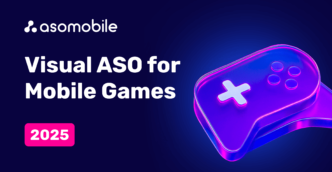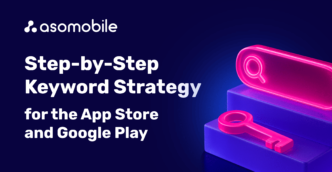ASO optimization: the history of its origin and its place in the development cycle
What is ASO optimization, when does it appear, and why is it needed?
App success is impossible without ASO optimization.
It's like a plane without turbines. Even if this aircraft is a hundred times more beautiful, functional, and roomy, it will not take off without a turbojet engine, that is, it will not be able to fulfill its primary function. It is the same with an app. Even the most useful, efficient, and technical app will not "take-off" without ASO optimization. Because the end-user simply won't know about it. They won't hear, they won't read, they won't see.
That is where the main goal of ASO optimization comes from - your app visibility on the App Store or Google Play
- top positions in the ranking
- the presence of the app in the recommendations of stores by category
- top charts
- featuring - getting into thematic collections of stores. All kinds of "Game of the Day", "Editor's Choice", "App of the Day," and many others
At the end of the article, you can find a 40% discount coupon for the first month of using ASOMobile - a tool for creating ASO and researching competitors in the mobile app market.
All ASO optimization is focused on increasing the visibility of your app for users. The more users see the app, the higher the chances of installing it. After all, installs are among the most important and monitored criteria for evaluating the app's success. All ASO specialists and developers keep a close eye on the install conversion funnel. It is impossible to overestimate the importance of this KPI. But it's easy to underestimate.
ASO has its methods and ways to achieve such an important goal.
There are many of them, but in general, they are aimed at improving:
- visual component
- text metadata
Visual optimization improves the graphic elements of the application - icons, screenshots, videos, and banners. Everything is simple here - visual content should be brief, but as informative as possible, explaining to the potential user the main functions of the application, and how exactly this application will be helpful to them. “Picture” should captivate the user. So they will look at all this visual splendor and ask themselves - how did I live without this wonderful application before?
Text optimization, on the other hand, is aimed at selecting keywords and phrases with a help of which your potential user is looking for an application through a store search engine. Metadata should contain as many keywords as possible - the name of the app, headings with subheadings, the keyword field itself, and the description. The more relevant your keywords are, the more efficient the algorithm works to suggest applications to users based on their search queries. Direct dependency.
And the last thing I would like to pay attention to is ASO optimization. Last but not least is the consistency of ASO.
Always and everywhere. Every free minute should be given to this tool to reach the top of the charts and search results. It is not enough to collect the core of keywords or create visual content once, even if it is as relevant matching, and informative as possible. It's still not enough to do it once. Or even two. Or three. The keyword of all ASO optimization is persistence. Regularity. Because:
- the application market does not stand still, it is developing dynamically every second. Algorithms are learning, competitors are expanding, and more and more new applications are being created.
- users also do not lag behind the market, but rather even shape it. Users constantly want to make their lives more comfortable, cozier, and easier and they go for all that where? That's right, to stores that offer them ready-made solutions to their problems and headaches. On stores that fill their lives with convenience. An app that solves their problems - they disperse boredom, allows them to be lazy, monitor their health, develop and educate. Because modern apps themselves will give you an interesting idea, count calories and remind you to drink water, and tell you about the lesson. And there are a lot of such problems and their solutions in the form of apps.
Everything flows, everything changes. And what was relevant yesterday is already a distant past for today. That is why it is important to constantly keep abreast of the market and its users and respond to changes and new trends in a timely manner.
But the past can also be useful. Especially when it comes to the history of ASO optimization.
So, how did ASO optimization come about?
In the beginning, was the word. But seriously, stores appeared in the beginning, you can read more about the evolution of app stores here - App Store and Google Play, but first things first.
- Birthday:
App Store 07/10/2008
Google Play 10/22/2008. Actually, then it was the Android Market
- What did they start with?
App Store had 500 apps
Google Play was more modest with just 50 ones
- And now?
The App Store offers users just under 2 million apps
Google Play is richer - about 2.8 million (update numbers)

Why did ASO optimization appear?
The App Store and Google Play opened, almost like Columbus discovered America, a fundamentally new niche, a fresh opportunity to make money. And app developers came to them. Millions of developers. The App Store and Google Play became exponentially filled with applications. In order for users to install a particular app, it was required that they first find it, and then also want to install that one, and not another of many similar ones. The competition was growing. The situation was heating up.
It is in this tense moment that ASO optimization is born.
ASO is a way to increase the visibility of a particular application to the end-user. Why increase visibility? To increase conversion per install, of course!
ASO optimization was born and developed. At the moment, the evolution of ASO can be divided into three main stages:
- By 2009, along with the expansion of the App Store and Google Play, the term ASO (App Store Optimization) began to spread.
There was still no deep understanding of ASO optimization itself, so the ASO strategy as a whole was limping on both legs. The highlights were
- SEO vs ASO
It is here that the common expression that "in the beginning, there was a word" is appropriate. As ASO strongly resembled SEO. The maximum concentration on keywords is in the name of the application itself and, of course, in the keywords field.
- App advertising
In the realities of that still very young market, a weekly advertisement could bring about 3 million installations!
- ASO black hat
Yes, the App Store and Google Play algorithms were just developing, as was ASO optimization itself, so many developers did not hesitate, for example, to pay users to install their app. Paid installs raised the app in the store rankings, their visibility was growing, increasing organic installs.
- ASO optimization is being structured, becoming a common practice
The market is saturated with more and more new applications, competition is getting tougher, and keywords and simple advertising are less effective. Traffic manipulations are suppressed by the stores, up to the bans of unscrupulous companies. The funnel of conversion into useful action is taken out of the dusty chest into the light of day and begins to be intensively optimized. Because the more effective the conversion optimization, the more successful the application is - now it's clear to everyone.
- Rethinking search results
ASO is no longer equal to SEO. Awareness of the differences between searches on web resources and on stores. The introduction of tools that are effective in the realities of the App Store and Google Play - an organic keyword strategy and their paid search.
- Understanding the Importance of Views
After all, views are a significant part of the conversion funnel. Therefore, a UA strategy (paid user acquisition) is being implemented and metadata is being optimized. And, of course, placement of impressions in the right places.
- Analysis, analysis, and more analysis
User audience, metadata, information from UA channels, and everything that can be wrapped in numbers and statistics. The more data is analyzed, the better and more targeted the ASO strategy is.
- ASO 2022 and current year trends:
- In-app events and their impact on ASO optimization
- A/B tests for iOS applications
- Changes to Google's metadata requirements policy
- Video and screenshots in the context of the new requirements of the Google Play Market
- Google Play Security Policy
- Ratings and reviews in the Google Play Market
You can read about the current situation in the mobile app market and ASO optimization trends here.
In the meantime, let's take a walk to the origins, without any exaggeration, the basics of the basics - to the development of mobile apps and determine the role of ASO optimization in this process

Mobile apps bring in billions of dollars through the App Store and Google Play and the actual advertising within the apps themselves. But, if your app is not effective, then it is stupid to count on a piece of the pie from these billions. And do not forget that the mobile app market is becoming more competitive and sharp every day. In order for your app to be noticeable, visible, and, therefore, bring you income in such difficult conditions, you need to create not just a good service, but an excellent, unique one, if you like. Useful, necessary, interesting, convenient, and don't forget about users' pain points. Your app should solve their problems. Be competitive. Be promising. Your app should have an idea to both solve the problems of users and ease their pain.
In general, your app should have a lot of things, but neither the market nor its users should have anything at all. You need to create something that will make users gasp. And then launch your creation in the stores and hope that they still gasp. And, if they do not grasp, the best thing you can do is not give up and make every effort to still achieve the wow effect.
But it's too early to hang your nose. In many ways, user delight and excitement depend on two things:
- The application itself
- Competent ASO strategy and subsequent promotion.
Let's start with application development
Mobile app development is a combo. Here we will need creativity, analytics, marketing, and modern technologies. Developers have their own approaches, but in general, the following main stages can be distinguished.
- Planning, research, analytics, strategy
It all starts with an idea of a future product. Some gurus recommend starting, on the contrary, with an analysis of the market and user problems. They say it is easier - there is a problem, and you come up with a solution. Allegedly, this way is easier - it's a shame to create an idea and then painfully think about what problem it solves after all. Here everyone chooses their own path.
We will set out on the beaten track. So, you have an idea and its main vision as a ready-made app. This idea requires detailing. It is usually at this stage when it is determined with the target audience, tasks, and KPI of the application, which platforms the future application will be available for (iOS, Android). From here, by the way, a hybrid approach comes up, or an original one for each of the platforms. Usually, platforms are chosen according to the level of competition and the number of target audiences on a particular platform.
It also carries out some marketing research, analysis of the market and its competitors, including indirect ones, and analyzes technical and economic justifications.
All this is aimed at getting a very important answer to an equally important question - if your idea, the app, has a niche in the market? Well, not to waste money on development.
- As a result, we have MVP - the minimum viable product. It is an experimental concept and a reference as well.
- Specifications, Terms of Reference, Warframes
Here are the technical requirements for the future application for developers. Describes functionality and design, system logic and user mechanics (interface), security and reliability, performance, and content. Separately, user characters and their stories are described, and user travel maps are being worked out. From all of the above, warframes are formed - black and white pages of the application, like a primary visualization of buttons, graphics, and text.
- As a result, we have an exact understanding of what the app consists of and, therefore, we have a specific estimate.
- Design
Briefly, the path looks like this: design concept - user interface (all sorts of buttons, fields, forms) - design layouts - interactive prototypes.
And remember that UI design is responsible for the appearance of the application, and UX design is responsible for how this interface works and interacts with itself and the user.
- As a result, we have an interactive prototype of the app.
- Programming and development
The main task of the stage is the implementation of the product. The code for the final version of the app is being written.
- We see the results of the developers' righteous work - an almost ready application.
- Testing
It is necessary that your application works like a Swiss watch. Adequately, reasonably and efficiently combine testing with application development. Even our world exists with a huge number of errors and bugs. Foreseeing absolutely everything will not work, keep perfectionism and save your nerves. It is better to connect a tester at the stage of application development, especially since the payment for his services per hour is cheaper than the same hour of the developer's work. The tester and the developer do not have to be the same person. Thus, the freshness of the look is lost. And let testing be continuous throughout the entire development stage, this will save your resources (at least money and time, not to mention nerves) in the future, in the process of maintaining a ready-made and running application.
- As a result, we have found and corrected errors.
- App release on stores
Congratulations! Your app has gone to the masses. But first, of course, the App Store and Google Play will moderate it. And, by the way, each new version of the application will be moderated.
- We have the release of your application, which starts working and brings you money.
- Technical support and maintenance, development
It starts in parallel with the launch of the app in the stores. And it does not stop for a second while your app is present in these stores.
NB: all these steps will be repeated in one way or another throughout the presentation of your application on the App Store and Google Play. It's cyclical. Constantly. Continuously. Actually, like ASO optimization of an already running application. These are the two constants, the two wings of your app's success.
And where there are wings, there are airplanes)
The place of ASO optimization in the app development process
Throughout the article, we constantly compare ASO optimization with the engine. Because in our opinion - this is the most accurate comparison. It is not enough to test and fix bugs for the app to meet the original requirements specification. The application, like a child, needs to be developed. Mistakes should definitely be fixed. But it is also necessary to optimize for new market trends. And the mood of users must also be taken into account. Experiment with graphics and text. Study the target audience and adapt your app to it and your goals. Understand user pain and anticipate problems. Improving your product every second is what ASO optimization is all about. And remember that successful ASO optimization is part of your success strategy.
Mobile analytics tools and their place in the app development process
Despite the fact that ASO optimization itself will be at the final stage of application development, namely at the time of release in app stores, mobile analytics tools also solve marketing problems at the time of planning and strategy.
How to use ASOMobile mobile analytics to understand your potential competitors and the mobile app market as a whole - our blog article TOP 10 TOOLS FOR ANALYZING COMPETITORS IN THE MOBILE APPLICATION MARKET. But in short:
- Store Insights is a tool for a complete analysis of Google Play and App Store mobile app stores and choosing the most profitable niche.
- To get the maximum amount of data, it is essential to analyze relevant and popular applications. To do this, research the Top 100 apps in your category in the Category Intelligence tool.
- Downloads is a tool with the help of which you can observe the dynamics of downloads for any app. Likewise, you can keep income dynamics for any application using the Revenue tool.
- If you find yourself selecting a popular application, you are almost guaranteed to receive additional traffic. With the help of the Similar Apps tool, you can find out which apps your app or competitors fall into.
This is not a complete list of all the possibilities for analyzing the mobile application market and the competitive environment. Careful analysis and detailed planning will allow your application to get off to a good start and make further progress less costly and more effective.
 Українська
Українська  Русский
Русский  Español
Español 






